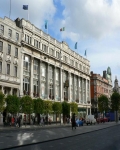OConnell Street
Archaeology »
Archaeological Monuments » OConnell Street
OConnell Street - Ireland
OConnell Street is located in O'Connell Street,Dublin.
OConnell Street monument was established on 1924.
Primary threats to OConnell Street :
The sun rising to the east and setting in the west illuminates the alternate sides of the street over the course of the day, while for the most part it is lit directly from the south. This helps in making the thoroughfare two or three degrees warmer than windswept O'Connell Bridge or the city quays.
Historical facts of OConnell Street :
- O'Connell Street, located in the heart of Dublin, Ireland, is one of the city's most iconic and historically significant thoroughfares. Named after the Irish political leader Daniel O'Connell, the street has witnessed pivotal moments in Irish history and has evolved into a bustling center for culture, commerce, and social gatherings.
- The origins of O'Connell Street can be traced back to the late 18th century when it was known as Sackville Street, named after Lionel Sackville, the first Duke of Dorset. However, in the early 20th century, the street was renamed in honor of Daniel O'Connell, a prominent Irish statesman and champion of Catholic emancipation.
- O'Connell Street has been the site of numerous significant events throughout Irish history. One of the most notable events took place in 1916 during the Easter Rising, a rebellion against British rule. The General Post Office (GPO) on O'Connell Street served as the headquarters for the rebels, and it became a focal point of the uprising. Although the rebellion was ultimately suppressed, it marked a pivotal moment in the fight for Irish independence.
- Another historic event that unfolded on O'Connell Street was the Battle of Dublin in 1922 during the Irish Civil War. The street became a battleground as opposing factions, supporting either the newly formed Irish Free State or the anti-treaty forces, clashed for control of the city. The GPO once again played a central role in the conflict, with its façade heavily damaged by artillery fire.
- Throughout the years, O'Connell Street has been a venue for political rallies, protests, and commemorations. It has witnessed speeches by influential figures such as Eamon de Valera and has been a gathering place for the Irish people to express their aspirations and demands for a united and independent Ireland.
- O'Connell Street is also home to several significant monuments and landmarks. The most prominent among them is the Daniel O'Connell Monument, an imposing statue of the revered statesman. Designed by John Henry Foley, the statue was unveiled in 1882 and stands at the lower end of the street. It serves as a tribute to O'Connell's efforts in advocating for the rights and welfare of the Irish people.
- Additionally, the Spire of Dublin, officially known as the Monument of Light, stands tall at the northern end of O'Connell Street. This modern stainless-steel monument, erected in 2003, has become an iconic symbol of Dublin and a meeting point for locals and tourists.
- O'Connell Street is also known for its vibrant commercial and cultural scene. It is lined with shops, restaurants, theaters, and historic buildings, including the GPO, which now houses a museum and serves as a reminder of Ireland's struggle for independence.
- In conclusion, O'Connell Street in Dublin is more than just a thoroughfare. It is a place of historical significance, reflecting the trials and triumphs of the Irish people. From its role in the Easter Rising to its status as a center for political gatherings and demonstrations, the street embodies the spirit of Irish nationalism and the desire for independence. Today, O'Connell Street continues to thrive as a vibrant hub of activity, welcoming visitors from around the world to experience its rich history, culture, and the enduring spirit of the Irish people.

